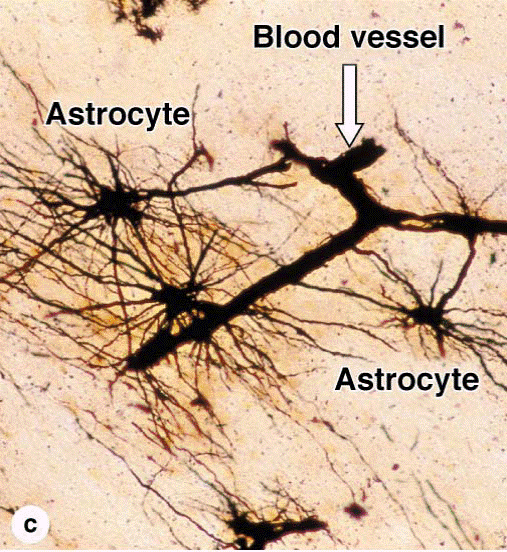
Oligodendrocytes (Gr. oligos, small, few + dendron, tree + kytos, cell) produce the myelin sheath that provides the electrical insulation for neurons in the CNS.
Oligodendrocytes extend processes that wrap around parts of several axons, producing a myelin sheath. They are the predominant glial cell in CNS white matter. The processes are not visible by routine light microscope staining, in which oligodendrocytes usually appear as small cells with rounded, condensed nuclei and unstained cytoplasm.
Astrocytes
Astrocytes (Gr. astron, star, + kytos) have a large number of radiating processes and are unique to the CNS. Astrocytes with relatively few long processes are called fibrous astrocytes and are located in the white matter; protoplasmic astrocytes, with many short, branched processes, are found in the gray matter. Astrocytes have supportive roles for neurons and are very important for proper formation of the CNS during embryonic and fetal development. Located mainly in gray matter, astrocytes are by far the most numerous glial cells and exhibit considerable morphologic and functional diversity.



Astrocytes.
(a): Astrocytes are the most numerous glial cells of the CNS and are characterized by numerous cytoplasmic processes (P) radiating from the glial cell body or soma (S).
Astrocytic processes are not seen with routine light microscope staining, but are easily seen after gold staining. Morphology of the processes allows astrocytes to be classified as fibrous (relatively few and straight processes) or protoplasmic (numerous branching processes), but functional differences between these types are not clear. X500. Gold chloride. (b): All astrocytic processes contain intermediate filaments of glial fibrillary acidic protein (GFAP) and antibodies against this protein provide a simple method to stain these cells, as seen here in a fibrous astrocyte (A) and its processes. The small pieces of other GFAP-positive processes in the neuropil around this cell give an idea of the density of this glial cell and its processes in the CNS. Astrocytes are an important part of the blood-brain barrier regulating entry of molecules and ions from blood into CNS tissue. Capillaries at the extreme upper right and lower left corners of (b) are enclosed by GFAP-positive perivascular feet (PF) at the ends of numerous
astrocytic processes. X500. Anti-GFAP immunoperoxidase and hematoxylin counterstain. (c): A length of capillary is shown here completely enclosed within stained processes of astrocytes. X400. Rio Hortega silver.
Дата добавления: 2015-10-30; просмотров: 131 | Нарушение авторских прав
| <== предыдущая страница | | | следующая страница ==> |
| Synaptic Communication | | | Layers of the eye. |